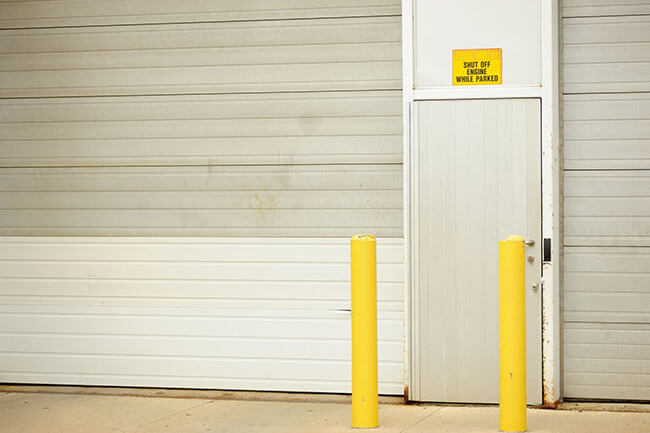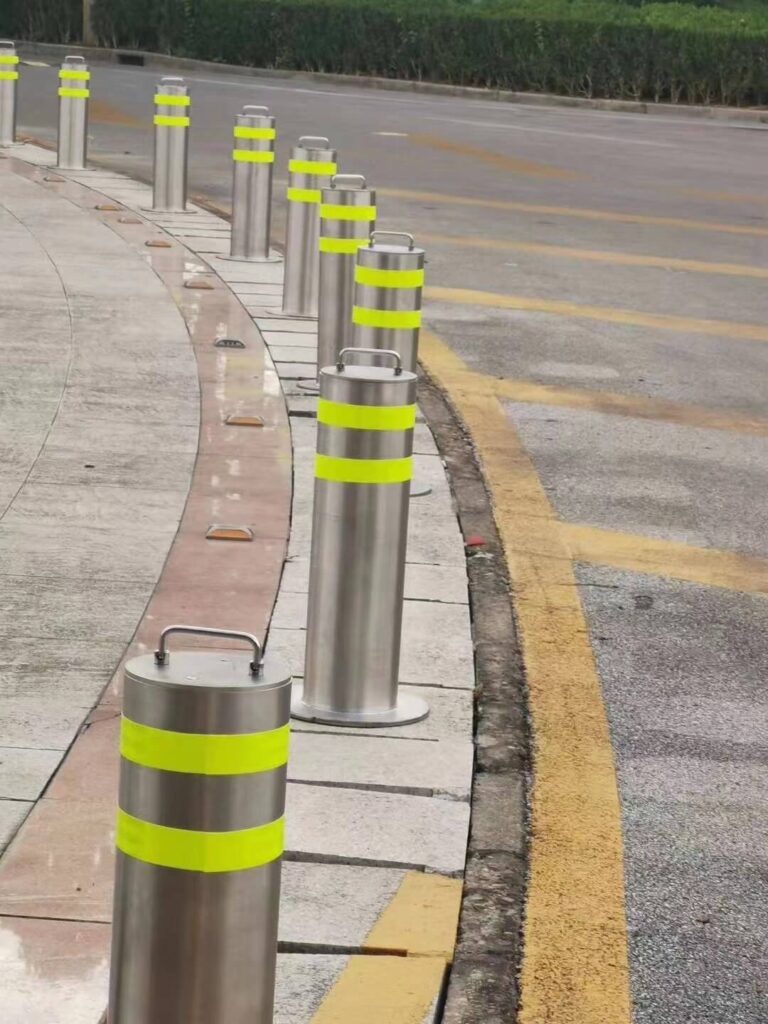Introdução
In fast-paced, high-risk environments like factories, warehouses, and loading docks, yellow bollards serve as essential safety components. These bollards don’t just protect structures and equipment—they also create a clear boundary that helps protect pedestrians and workers from accidental collisions and keep equipment like forklifts and delivery trucks on designated paths.
Here’s why choosing the perfect yellow bollard for industrial use can make a significant difference in your facility’s safety and efficiency:
- High Visibility: Yellow is universally recognized as a color of caution. In industrial settings, yellow bollards are easy to see from a distance, even in dim lighting or through fog or dust. This makes them an effective way to alert drivers and pedestrians to potential hazards.
- Effective Barrier Protection: Industrial sites often have large, powerful machinery and frequent vehicular traffic. A well-placed yellow bollard can prevent unauthorized vehicle access and help guide equipment and workers through safe, designated routes.
- Versatile Applications: Whether you need fixed, removable, or retractable options, yellow bollards are adaptable to a variety of uses and can be customized for specific industrial needs. From permanent barriers to flexible access points, they help maintain a well-organized and secure environment.
- Industrial Standards Compliance: In many industries, safety regulations require specific barrier types and visibility standards. Yellow bollards can help ensure your facility complies with these standards, making it easier to meet OSHA and ANSI guidelines.
The right yellow bollard for your facility is more than just a safety addition; it’s a critical part of maintaining a secure, productive environment.

Why Yellow Bollards Are Essential for Industrial Safety
In an industrial setting, yellow bollards are a crucial safety feature. Their bright color and sturdy design contribute to a safer environment, serving both functional and psychological purposes that prevent accidents and reinforce safety protocols.
Understanding the Role of Yellow Bollards in Industrial Environments
Yellow bollards are commonly installed in areas where there is a mix of vehicle and foot traffic, heavy machinery, and expensive equipment. Here’s why they’re essential:
- High-Visibility Barrier: Yellow bollards are hard to miss, which means drivers and pedestrians are more likely to notice and avoid restricted areas. This heightened visibility reduces the risk of accidental collisions.
- Traffic Control and Zone Division: In busy industrial sites, yellow bollards help guide vehicles along safe pathways and establish clear boundaries for pedestrian zones. This separation minimizes the chances of accidents between workers on foot and moving machinery.
- Asset and Equipment Protection: Bollards act as a physical barrier that protects valuable equipment, walls, and loading docks from vehicle impact. By positioning bollards strategically, you safeguard your facility’s assets from costly damage.
The Psychology and Practicality of the Color Yellow in Safety
The color yellow plays a psychological role in ensuring safety:
- Universal Color for Caution: Yellow is internationally recognized as a warning color. From road signs to safety gear, yellow alerts people to potential hazards and signals the need for caution. Yellow bollards convey this sense of caution, encouraging drivers and pedestrians to slow down and stay alert.
- Enhanced Perception in Low Visibility Conditions: Yellow is more visible in low-light environments, which is especially valuable in industrial settings where lighting conditions can vary. Whether it’s early morning or late evening shifts, yellow bollards are easy to spot.
Industries and Settings Where Yellow Bollards Are a Requirement
Some industries and facilities benefit significantly from installing yellow bollards due to the high-risk environment. These include:
- Warehouses and Distribution Centers: Warehouses rely heavily on forklifts and other machinery that require clear pathways. Yellow bollards help guide these vehicles and prevent accidental intrusions into pedestrian zones.
- Factories and Manufacturing Facilities: In factories where heavy machinery operates, yellow bollards establish a safety boundary around dangerous equipment and high-risk areas.
- Parking Lots and Loading Docks: These areas are high-traffic zones where visibility is essential. Yellow bollards help create clear zones for vehicles and protect building structures.
- Construction Sites: Temporary bollards are often used to secure high-risk areas on construction sites, ensuring the safety of both workers and visitors.
In each of these environments, choosing the perfect yellow bollard for industrial use isn’t just a safety measure; it’s a vital part of operational efficiency and accident prevention.
Key Considerations When Choosing a Yellow Bollard
Choosing the perfect yellow bollard for industrial use requires attention to several important factors. Not all bollards are created equal, and selecting the right one ensures maximum safety, durability, and value for your industrial setting.

Material Selection for Industrial Bollards
The material of a bollard determines its durability, impact resistance, and maintenance needs. In industrial settings, some of the most common materials for bollards include:
- Steel: Known for its strength, steel is ideal for heavy-duty applications where high-impact resistance is essential. Steel bollards are often used in areas where forklifts, trucks, and other vehicles operate frequently.
- Concrete: These bollards provide a strong, immovable barrier that can withstand high impact. Concrete is ideal for permanent installations, such as around building perimeters and in parking lots. However, it may require regular maintenance to prevent cracking.
- Polymer and Plastic: Polymer bollards, especially those with a steel core, offer flexibility combined with durability. They’re often used in low-impact areas or where flexibility is an advantage, as they can absorb minor impacts without significant damage.
When selecting a material, consider the level of protection needed, the types of vehicles or machinery in the area, and the potential wear and tear the bollard will face.
Impact Resistance and Durability
Impact resistance is a critical factor in bollard selection, especially in high-traffic areas. Here’s what to keep in mind:
- High-Impact Bollards for Heavy-Duty Areas: In locations where vehicles like trucks and forklifts operate, high-impact bollards are a must. These bollards can prevent significant damage by stopping or redirecting a vehicle in case of accidental impact.
- Standards and Certifications: Look for bollards that meet industry standards for impact resistance, such as ASTM or PAS 13 certifications. These standards ensure the bollard is designed to withstand specific impact forces, giving you confidence in its durability and performance.
Height and Diameter
The size of a bollard plays an essential role in its effectiveness. Choosing the right height and diameter based on the intended application is important:
- Tall and Wide Bollards for High-Risk Areas: Taller, wider bollards are better suited for high-risk areas where large vehicles operate. They are more visible and provide a stronger deterrent.
- Low-Profile Bollards for Pedestrian Areas: In pedestrian-heavy areas, shorter bollards are often sufficient and can be more aesthetically pleasing. However, they should still be high enough to prevent accidental collisions.
Selecting the right height and diameter helps ensure the bollard’s visibility and functionality without compromising the visual appeal or accessibility of the area.
Visibility and Aesthetic Appeal
While safety is the primary purpose, bollards can also contribute to the visual design of a space:
- Reflective Strips: Adding reflective strips to yellow bollards enhances visibility at night or in low-light conditions, making them easier to spot and avoid.
- Cor e acabamento: Yellow is the standard color for safety, but additional finishes like powder-coating can enhance durability and weather resistance. Some industrial settings may also require custom colors or designs to align with brand aesthetics or specific safety requirements.
Choosing the right combination of material, impact resistance, size, and visibility features will help ensure your bollards meet the unique demands of your industrial environment. This strategic approach to choosing the perfect yellow bollard for industrial use maximizes both safety and durability, creating a safer workspace for everyone involved.
Types of Yellow Bollards Suitable for Industrial Use
When choosing the perfect yellow bollard for industrial use, it’s important to know the different types available and their ideal applications. Each type serves specific purposes, from permanent barriers to flexible, removable options.
Fixed Bollards
Fixed, or permanent, bollards are designed to provide ongoing protection and boundary control. They are ideal for industrial settings where a consistent barrier is required.
- Objetivo: Permanent protection for areas requiring consistent access control, such as around building perimeters, loading docks, or parking zones.
- Installation: Embedded in concrete or bolted down, making them extremely durable and resistant to impact.
- Best For: High-traffic areas where security and protection from heavy machinery are priorities.

Dissuasores amovíveis
Removable bollards offer flexibility by allowing you to secure areas when needed but remove the barriers when temporary access is required.
- Objetivo: Flexibility in access control, particularly useful for entry points or zones that periodically require vehicle access.
- Installation: Often installed with a lockable ground sleeve, enabling quick removal and reinstallation.
- Best For: Locations where vehicle access may be necessary at certain times, such as loading docks or restricted access points.
Retractable and Collapsible Bollards
These bollards provide similar flexibility to removable bollards but feature a retractable mechanism that allows them to be lowered into the ground or collapsed as needed.
- Objetivo: Ideal for areas requiring temporary vehicle access with minimal manual labor for setup or removal.
- Installation: Mounted in a way that allows them to retract or fold down when not in use, offering a streamlined appearance and flexibility.
- Best For: Sites where occasional vehicle entry is required, such as emergency access lanes or entrance points that need to be kept clear most of the time.
Flexible Bollards
Flexible bollards are designed to bend upon impact, absorbing the energy rather than halting the vehicle entirely. These bollards are particularly useful in lower-risk areas or where flexibility is prioritized over impact resistance.
- Objetivo: Absorb light impacts without sustaining significant damage, ideal for separating pedestrian paths or low-traffic zones.
- Installation: Typically mounted with a base that allows them to bend and flex when hit.
- Best For: Low-impact areas, bike lanes, or spaces where visual barriers are needed without heavy-duty protection.
Choosing the Right Type for Your Facility
Each type of yellow bollard has unique strengths that make it suitable for specific industrial uses. When determining which is best for your facility, consider:
- Level of Security: Fixed bollards offer the most secure, permanent solution, while flexible or retractable options provide adaptable access.
- Frequency of Access: Removable or retractable bollards are ideal if you need occasional access for vehicles or equipment.
- Impact Resistance Needs: For high-impact zones, opt for fixed or robust removable bollards; flexible bollards are suited for lower-impact areas.
By aligning the bollard type with your facility’s unique requirements, you ensure the best performance and durability, enhancing safety while optimizing access control. Thoughtfully choosing the perfect yellow bollard for industrial use not only improves safety but also supports the overall operational efficiency of your industrial space.
Installation and Placement Best Practices for Yellow Bollards
Once you’ve selected the perfect yellow bollard for industrial use, proper installation and placement are essential to maximize its effectiveness and durability. Following best practices for bollard spacing, installation, and maintenance helps create a safer and more organized industrial environment.
Proper Spacing and Alignment in Industrial Settings
Ensuring the correct spacing between bollards helps prevent unauthorized access and enhances visibility:
- Spacing for Pedestrian and Vehicle Areas: For clear separation between pedestrian paths and vehicle lanes, place bollards at regular intervals that prevent vehicles from passing through but allow easy pedestrian access.
- Optimized Visibility: Bollards should be aligned to maintain sightlines for vehicle operators. When lined up correctly, they create a visible barrier without obstructing views, reducing the chance of accidents.
Installation Methods
The method of installation impacts a bollard’s durability and effectiveness. Select the installation technique that best matches the bollard type and site conditions:
- Direct Bury: Fixed bollards are often installed by embedding them directly into concrete, providing a strong, permanent base. This method is best for high-impact areas where bollards need to withstand heavy forces.
- Bolt-Down: Bolt-down bollards are secured using anchor bolts, making them sturdy but easier to replace if needed. This method is suitable for areas where frequent maintenance or relocation may be necessary.
- Ground Sleeves for Removable Bollards: Installing removable bollards with lockable ground sleeves allows quick removal when access is required. This method provides flexibility while keeping the bollards secure when in place.

Maintaining High Visibility and Safety
Keeping yellow bollards highly visible and functional is key to ensuring they remain effective as safety barriers:
- Regular Cleaning: Dust, dirt, and industrial residues can reduce the visibility of yellow bollards. Routine cleaning helps maintain their bright color, ensuring they remain noticeable.
- Repainting or Covering: Over time, bollards may experience wear that diminishes their visibility. Repainting or adding covers with reflective strips can restore their appearance and improve nighttime visibility.
- Damage Inspection: Regular inspections help identify any structural damage from impacts. Addressing minor damage early on prevents the need for costly replacements and ensures continuous protection.
Legal and Safety Compliance
Installing bollards in line with industry standards and regulations ensures that your facility meets legal safety requirements:
- OSHA and ANSI Guidelines: These agencies have recommendations and guidelines for bollard placement in industrial facilities. Adhering to these standards helps you maintain a safe working environment and may reduce liability.
- Site-Specific Requirements: Certain areas, such as fire exits or emergency access lanes, may require specific bollard placements to comply with local safety codes. Be sure to understand and implement any regulations specific to your facility’s layout and operations.
By following these installation and maintenance practices, you’ll enhance the effectiveness and lifespan of your yellow bollards. Properly placed and well-maintained bollards not only improve safety but also contribute to a well-organized, compliant industrial site, achieving the goal of choosing the perfect yellow bollard for industrial use.
Perguntas frequentes
When choosing the perfect yellow bollard for industrial use, there are often questions about how to ensure maximum safety and effectiveness. Here are some frequently asked questions to help guide your selection and usage.
What makes yellow the best color for industrial bollards?
- High Visibility: Yellow is universally recognized as a warning color, making it ideal for areas requiring caution.
- Psychological Impact: Yellow naturally catches attention, encouraging people to slow down and remain alert. This is essential in high-risk areas with both foot and vehicle traffic.
How tall should a bollard be in a warehouse?
- Standard Height: Most industrial bollards range from 36 to 48 inches, depending on the location and level of visibility required.
- Consider Site Needs: In areas with high forklift traffic, a taller bollard may be preferable, while pedestrian-heavy zones may use shorter bollards that still maintain visibility without obstructing views.
Can yellow bollards be used outdoors in all weather conditions?
- Weather Resistance: Many yellow bollards are designed to withstand extreme weather, but materials matter. Steel bollards with weather-resistant coatings and concrete bollards are well-suited for outdoor use.
- Reflective Strips: Adding reflective strips or covers can further enhance visibility in foggy, rainy, or low-light conditions, making bollards effective even in challenging weather.
What are some alternative uses of bollards in industrial spaces?
- Equipment Protection: Bollards are often installed to protect machinery, storage racks, and sensitive equipment from accidental impact.
- Traffic Management: They help create clear paths for vehicles and separate pedestrian zones from vehicular areas, improving site organization and safety.
- Aesthetic Boundary Markers: In addition to safety, bollards can enhance the visual structure of a space, serving as boundaries without using traditional fencing.
Conclusão
In summary, choosing the perfect yellow bollard for industrial use is a key decision that impacts both safety and efficiency in any industrial setting. Yellow bollards provide the high visibility, durability, and flexibility required to protect workers, equipment, and facilities from potential hazards. When selecting and installing bollards, consider:
- Material: Choose the right material—such as steel or concrete—to match the level of impact resistance needed.
- Type: Opt for fixed, removable, retractable, or flexible bollards depending on access requirements and traffic flow.
- Proper Installation and Maintenance: Ensure bollards are spaced, installed, and maintained according to best practices to maximize their effectiveness.
Yellow bollards not only contribute to a safer work environment but also help organize industrial spaces, keeping pedestrian and vehicle zones clear and defined. By focusing on the unique demands of your facility, you can confidently choose and implement yellow bollards as an essential safety feature.
With the right approach to choosing the perfect yellow bollard for industrial use, you’re investing in a secure, efficient, and compliant workplace, ultimately protecting both your team and assets.




